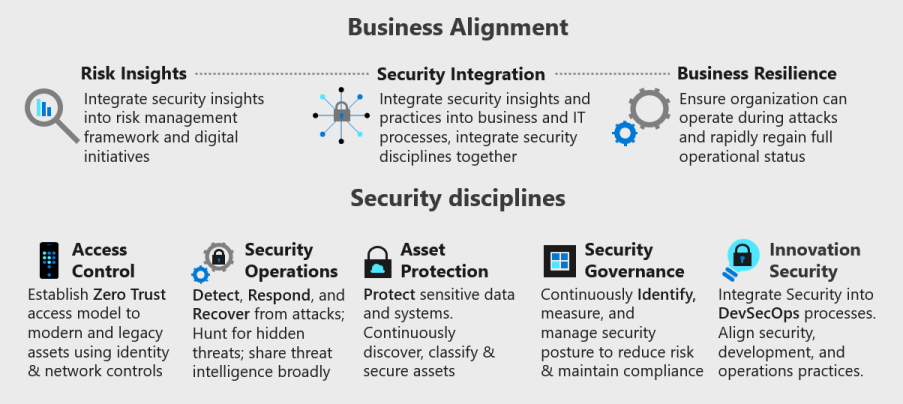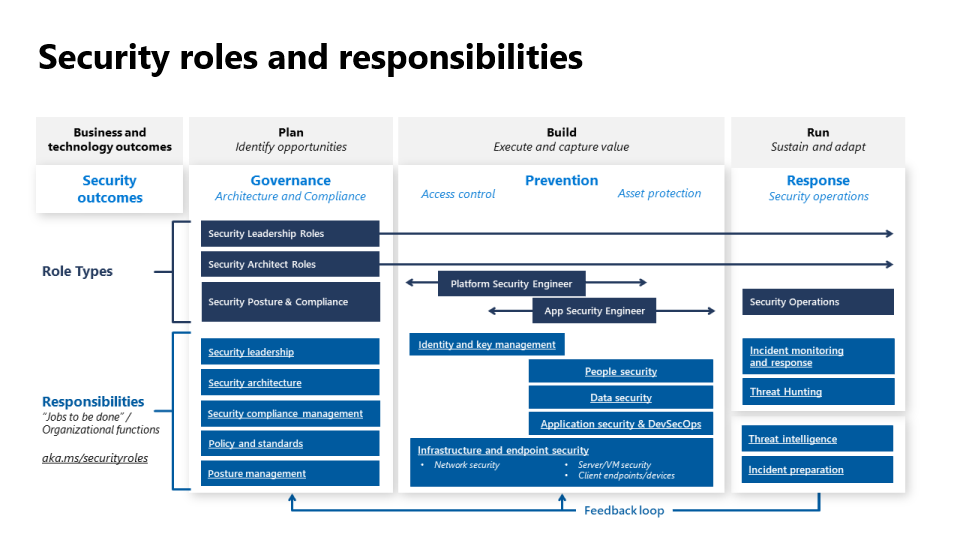Security in the Microsoft Cloud Adoption Framework for Azure
Just as cloud adoption is a journey, cloud security is an ongoing journey of incremental progress and maturity, not a static destination.
Envision a security end state
A journey without a target destination is just wandering. This approach might eventually lead to enlightenment, but business goals and constraints often require focusing on objectives and key results.
The Secure methodology provides a vision of the complete end state, which guides the improvement of your security program over time. The following visual maps the key ways that security integrates with a larger organization and shows the disciplines within security.
The Cloud Adoption Framework guides this security journey by providing clarity for the processes, best practices, models, and experiences. This guidance is based on lessons learned and real world experiences of real customers, Microsoft's security journey, and work with organizations, like NIST, The Open Group, and the Center for Internet Security (CIS).
The following video shows how the Secure methodology helps guide security improvements over time.
Map to concepts, frameworks, and standards
Security is a standalone organizational discipline and an attribute that's integrated or overlaid on other disciplines. It's difficult to precisely define and map in detail. The security industry uses different frameworks to operate, capture risk, and plan controls. The disciplines in the CAF Secure methodology relate to other security concepts and guidance in the following ways:
Zero Trust: Microsoft believes all security disciplines should follow the Zero Trust principles, which are assume breach, verify explicitly, and use least privilege access. These principles underpin any sound security strategy and must be balanced with business enablement goals. The first and most visible part of Zero Trust is in access control, so it's highlighted in the description of access control security discipline.
The Open Group: These security disciplines map closely to the Zero Trust components in the core principles white paper published by The Open Group where Microsoft actively participates. A notable exception is that Microsoft elevated the discipline of innovation security so that DevSecOps is a top-level element because of how new, important, and transformative this discipline is for many organizations.
NIST cybersecurity framework: For organizations that use the NIST cybersecurity framework, we have highlighted bold text where the framework most closely maps. Modern access control and DevSecOps map broadly to the full spectrum of the framework, so those items aren't noted individually.
Map to roles and responsibilities
The following diagram summarizes the roles and responsibilities in a security program.
For more information, see Cloud security functions.
Security transformation
When organizations adopt the cloud, they quickly find that static security processes can't keep up with the pace of change in cloud platforms, the threat environment, and the evolution of security technologies. Security must shift to a continuously evolving approach to match pace with this change. It transforms organizational culture and daily processes throughout the organization.
This methodology guides the integration of security with business processes and security technical disciplines. These processes and disciplines enable meaningful and sustainable progress on your security journey to reduce organizational risk. Few organizations can perfect all of these practices at once, but all organizations should steadily mature each process and discipline.
Change drivers
Security organizations experience two types of major transformations at the same time.
- Security as a business risk: Security has been propelled into the realm of business risk management from a purely technical quality-oriented discipline. The dual forces that drive security are:
- Digital transformation: Digital footprint increases continuously increase the potential attack surface of the organization.
- Threat landscape: Increases in attack volume and sophistication that are fueled by an industrialized attack economy with specialized skills and continual commoditization of attack tools and techniques.
- Platform change: Security is grappling with a technical platform change to the cloud. This shift is on the scale of factories shifting from running their own electrical generators to plugging into an electrical grid. While security teams often have the right foundational skills, they become overwhelmed by the changes to nearly every process and technology they use everyday.
- Shift in expectations: In the past decade, digital innovation has redefined entire industries. Business agility, especially agility related to digital transformation, can quickly unseat an organization as a market leader. Loss of consumer confidence can have a similar effect on the business. It was once acceptable for security to start with "no" to block a project and protect the organization. Now the urgency of embracing digital transformation must change the engagement model to "let's talk about how to stay safe while you do what's needed to stay relevant."
Guide lasting transformation
To transform how the business and tech teams view security requires aligning security to the priorities, processes, and risk framework. Key areas that drive success are:
- Culture: The culture of security must be focused on safely meeting the business mission, not impeding it. Security must become a normalized part of the culture of the organization. The internet, where the business operates, is open and allows adversaries to attempt attacks at any time. This cultural shift requires improved processes, partnerships, and ongoing leadership support at all levels to communicate the change, model the behavior, and reinforce the shift.
- Risk ownership: The accountability for security risk should be assigned to the same roles that own all other risks. This accountability frees security up to be a trusted advisor and subject matter expert rather than a scapegoat. Security should be responsible for sound and balanced advice that's communicated in the language of those leaders but shouldn't be held accountable for decisions they don't own.
- Security talent: Security talent is in a chronic shortage and organizations should plan how to best develop and distribute security knowledge and skills. In addition to growing security teams directly with technical security skill sets, mature security teams are diversifying their strategy by focusing on:
- Growing security skill sets and knowledge within existing teams in IT and within the business. These skills are especially important for DevOps teams with a DevSecOps approach. The skills can take many forms, such as a security help desk, identifying and training champions within the community, or job swapping programs.
- Recruiting diverse skill sets to security teams to bring fresh perspectives and frameworks to problems (like business, human psychology, or economics) and build better relationships within the organization.
Business alignment
Because of these shifts, your cloud adoption program should focus heavily on business alignment in three categories:
- Risk insights: Align and integrate security insights and risk signals or sources to the business initiatives. Ensure that repeatable processes educate teams on the application of those insights and hold teams accountable for improvements.
- Security integration: Integrate security knowledge, skills, and insights into daily operations of the business and IT environment. Incorporate repeatable processes and deep partnership at all levels of the organization.
- Operational resiliency: Ensure that the organization is resilient by continuing operations during an attack (even if at a degraded state). The organization should rapidly bounce back to full operation.
Security disciplines
This transformation affects each security discipline differently. Each of these disciplines is important and requires investment. The following disciplines are ordered (roughly) by which ones have the most immediate opportunities for quick wins as you adopt the cloud:
- Access control: The application of network and identity create access boundaries and segmentation to reduce the frequency and reach of security breaches.
- Security operations: Monitor IT operations to detect, respond, and recover from a breach. Use the data to continuously reduce the risk of a breach.
- Asset protection: Maximize the protection of assets, like infrastructure, devices, data, applications, networks, and identities, to minimize the risk to the overall environment.
- Security governance: Delegated decisions accelerate innovation and introduce new risks. Monitor decisions, configurations, and data to govern decisions made across the environment and within workloads across the portfolio.
- Innovation security: As an organization adopts DevOps models to increase the pace of innovation, security must become an integral part of a DevSecOps process. Integrate security expertise and resources directly into this high-speed cycle. This process involves shifting some decision making from centralized teams to empower workload-focused teams.
Guiding principles
Security activities should be aligned to and shaped by a dual focus on:
- Business enablement: Align to the organization's business objective and risk framework.
- Security assurances: Focus on applying the Zero Trust principles, which are:
- Assume breach: When you design security for a component or system, reduce the risk of an attacker expanding access by assuming other resources in the organization are compromised.
- Explicit verification: Explicitly validate trust by using all available data points, rather than assuming trust. For example, in access control, validate the user identity, location, device health, service or workload, data classification, and anomalies, rather than allowing access from an implicitly trusted internal network.
- Least-privileged access: Limit the risk of a compromised user or resource by providing just-in-time and just-enough-access (JIT/JEA), risk-based adaptive policies and data protection to help secure data and productivity.
Next steps
The Secure methodology is part of a comprehensive set of security guidance that also includes:
- Azure Well-Architected Framework: Guidance on securing your workloads on Azure.
- Security architecture design: Implementation-level journey of our security architectures. Browse the security architectures.
- Azure security benchmarks: Prescriptive best practices and controls for Azure security.
- Enterprise-scale landing zone: Azure reference architecture and implementation with integrated security.
- Top 10 security best practices for Azure: Top Azure security best practices that Microsoft recommends based on lessons learned across customers and our own environments.
- Microsoft Cybersecurity Architectures: The diagrams describe how Microsoft security capabilities integrate with Microsoft platforms and third-party platforms.
Feedback
Coming soon: Throughout 2024 we will be phasing out GitHub Issues as the feedback mechanism for content and replacing it with a new feedback system. For more information see: https://aka.ms/ContentUserFeedback.
Submit and view feedback for

